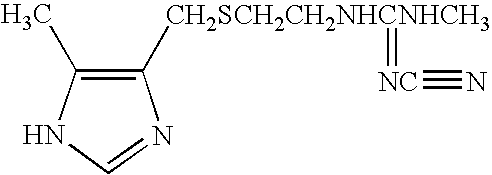Oral care compositions containing combinations of anti-bacterial and host-response modulating agents
a technology of host response and antibacterial agents, which is applied in the direction of drug compositions, aerosol delivery, metabolic disorders, etc., can solve the problems of affecting the overall affecting the health of people whose health is compromised, and increasing the risk of premature birth, etc., to achieve the effect of inhibiting and/or killing and modulating the host respons
- Summary
- Abstract
- Description
- Claims
- Application Information
AI Technical Summary
Benefits of technology
Problems solved by technology
Method used
Image
Examples
example i
e Compositions
[0142] The following oral care mouthrinse compositions according to the present invention are shown below with amounts of components in weight % These compositions are made using conventional methods.
ComponentIAIBICIDIEIFIGIHRiboflavin 5′-0.0260.0260.0260.0780.0260.026monophosphateEGCG0.1000.1000.100Cetylpyridinium0.0350.0700.0700.0500.0450.0750.0650.075Chloride (CPC)Domiphen————0.005——Bromide (DB)Zinc Lactate———0.250———0.050H2O2 35% soln.2.145Flavor / Coolant0.0800.2100.1200.1600.0800.1200.2000.070Glycerin23.000 20.000 23.000 13.000 5.0005.00013.000 18.000 Saccharin0.0250.0600.0180.0300.0250.0300.0100.013Sucralose0.008Poloxamer 407—0.1000.0500.025—0.0500.0500.001Propylene4.000GlycolMonosodium0.0850.050———0.0850.0500.053PhosphateDibasic Sodium0.0700.020———0.0700.0200.020PhosphateColor0.0200.0200.0100.0200.0200.0200.0200.020Ethanol———1.2005.000———Methylparaben0.020Propylparaben0.005WaterQSQSQSQSQSQSQSQS
Example II Dentifrice Compositions
[0143] Dentifrice compositions ac...
example iii
[0144] A study was conducted to evaluate the in vivo efficacy of a riboflavin+cetyl pyridinium chloride (CPC) rinse in a canine model. At the beginning of the study beagle subjects received a prophylaxis. Approximately one week later, they were graded for baseline Gingival Index (GI) and Plaque Index. Gingival Index is a 0-3 scale (0=no inflammation; 1=inflammation present, gingiva is red; 2=bleeding upon probing; 3=spontaneous bleeding). Plaque Index is percent plaque coverage of each tooth. The dogs were randomly allocated into treatment groups balanced on baseline inflammation index (II) scores using a SAS randomization program. Treatments began the day after allocation. The animals were treated topically on the teeth / gingiva with a spray mist bottle twice daily during the week and once daily on weekends for thirty days (30 ml / treatment). At the end of thirty days, the animals received final clinical grading.
[0145] Clinical gradings were done at baseline ...
PUM
| Property | Measurement | Unit |
|---|---|---|
| birth weight | aaaaa | aaaaa |
| DLS | aaaaa | aaaaa |
| periodontal probing depth | aaaaa | aaaaa |
Abstract
Description
Claims
Application Information
 Login to View More
Login to View More - R&D
- Intellectual Property
- Life Sciences
- Materials
- Tech Scout
- Unparalleled Data Quality
- Higher Quality Content
- 60% Fewer Hallucinations
Browse by: Latest US Patents, China's latest patents, Technical Efficacy Thesaurus, Application Domain, Technology Topic, Popular Technical Reports.
© 2025 PatSnap. All rights reserved.Legal|Privacy policy|Modern Slavery Act Transparency Statement|Sitemap|About US| Contact US: help@patsnap.com

